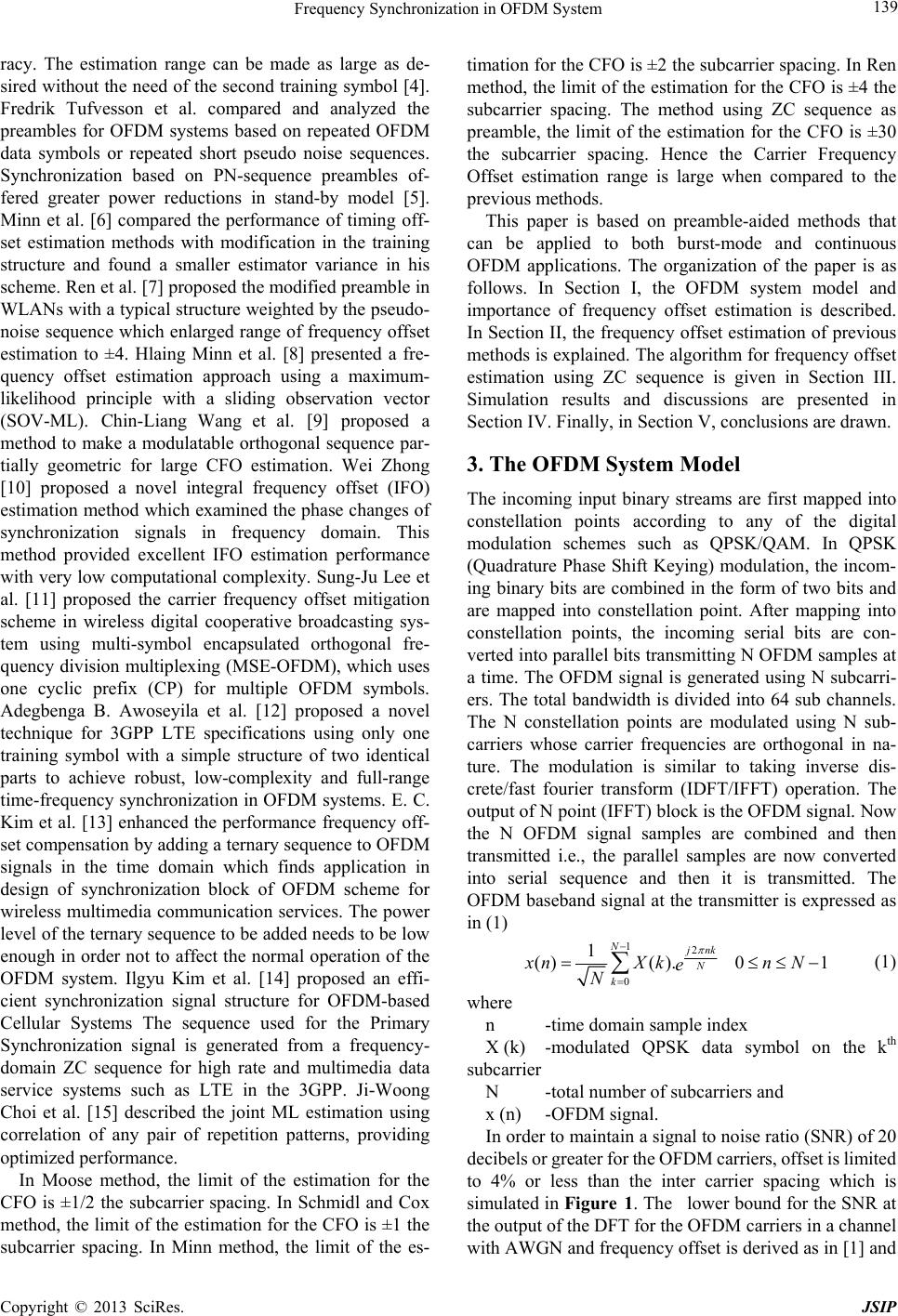
Frequency Synchronization in OFDM System 139
racy. The estimation range can be made as large as de-
sired without the need of the second training symbol [4].
Fredrik Tufvesson et al. compared and analyzed the
preambles for OFDM systems based on repeated OFDM
data symbols or repeated short pseudo noise sequences.
Synchronization based on PN-sequence preambles of-
fered greater power reductions in stand-by model [5].
Minn et al. [6] compared the performance of timing off-
set estimation methods with modification in the training
structure and found a smaller estimator variance in his
scheme. Ren et al. [7] proposed the modified preamble in
WLANs with a typical structure weighted by the pseudo-
noise sequence which enlarged range of frequency offset
estimation to ±4. Hlaing Minn et al. [8] presented a fre-
quency offset estimation approach using a maximum-
likelihood principle with a sliding observation vector
(SOV-ML). Chin-Liang Wang et al. [9] proposed a
method to make a modulatable orthogonal sequence par-
tially geometric for large CFO estimation. Wei Zhong
[10] proposed a novel integral frequency offset (IFO)
estimation method which examined the phase changes of
synchronization signals in frequency domain. This
method provided excellent IFO estimation performance
with very low computational complexity. Sung-Ju Lee et
al. [11] proposed the carrier frequency offset mitigation
scheme in wireless digital cooperative broadcasting sys-
tem using multi-symbol encapsulated orthogonal fre-
quency division multiplexing (MSE-OFDM), which uses
one cyclic prefix (CP) for multiple OFDM symbols.
Adegbenga B. Awoseyila et al. [12] proposed a novel
technique for 3GPP LTE specifications using only one
training symbol with a simple structure of two identical
parts to achieve robust, low-complexity and full-range
time-frequency synchronization in OFDM systems. E. C.
Kim et al. [13] enhanced the performance frequency off-
set compensation by adding a ternary sequence to OFDM
signals in the time domain which finds application in
design of synchronization block of OFDM scheme for
wireless multimedia communication services. The power
level of the ternary sequence to be added needs to be low
enough in order not to affect the normal operation of the
OFDM system. Ilgyu Kim et al. [14] proposed an effi-
cient synchronization signal structure for OFDM-based
Cellular Systems The sequence used for the Primary
Synchronization signal is generated from a frequency-
domain ZC sequence for high rate and multimedia data
service systems such as LTE in the 3GPP. Ji-Woong
Choi et al. [15] described the joint ML estimation using
correlation of any pair of repetition patterns, providing
optimized performance.
In Moose method, the limit of the estimation for the
CFO is ±1/2 the subcarrier spacing. In Schmidl and Cox
method, the limit of the estimation for the CFO is ±1 the
subcarrier spacing. In Minn method, the limit of the es-
timation for the CFO is ±2 the subcarrier spacing. In Ren
method, the limit of the estimation for the CFO is ±4 the
subcarrier spacing. The method using ZC sequence as
preamble, the limit of the estimation for the CFO is ±30
the subcarrier spacing. Hence the Carrier Frequency
Offset estimation range is large when compared to the
previous methods.
This paper is based on preamble-aided methods that
can be applied to both burst-mode and continuous
OFDM applications. The organization of the paper is as
follows. In Section I, the OFDM system model and
importance of frequency offset estimation is described.
In Section II, the frequency offset estimation of previous
methods is explained. The algorithm for frequency offset
estimation using ZC sequence is given in Section III.
Simulation results and discussions are presented in
Section IV. Finally, in Section V, conclusions are drawn.
3. The OFDM System Model
The incoming input binary streams are first mapped into
constellation points according to any of the digital
modulation schemes such as QPSK/QAM. In QPSK
(Quadrature Phase Shift Keying) modulation, the incom-
ing binary bits are combined in the form of two bits and
are mapped into constellation point. After mapping into
constellation points, the incoming serial bits are con-
verted into parallel bits transmitting N OFDM samples at
a time. The OFDM signal is generated using N subcarri-
ers. The total bandwidth is divided into 64 sub channels.
The N constellation points are modulated using N sub-
carriers whose carrier frequencies are orthogonal in na-
ture. The modulation is similar to taking inverse dis-
crete/fast fourier transform (IDFT/IFFT) operation. The
output of N point (IFFT) block is the OFDM signal. Now
the N OFDM signal samples are combined and then
transmitted i.e., the parallel samples are now converted
into serial sequence and then it is transmitted. The
OFDM baseband signal at the transmitter is expressed as
in (1)
12
0
1
()(). 01
Njnk
N
k
xnX knN
e
N
(1)
where
n -time domain sample index
X (k) -modulated QPSK data symbol on the kth
subcarrier
N -total number of subcarriers and
x (n) -OFDM signal.
In order to maintain a signal to noise ratio (SNR) of 20
decibels or greater for the OFDM carriers, offset is limited
to 4% or less than the inter carrier spacing which is
simulated in Figure 1. The lower bound for the SNR at
the output of the DFT for the OFDM carriers in a channel
with AWGN and frequency offset is derived as in [1] and
Copyright © 2013 SciRes. JSIP